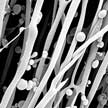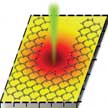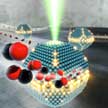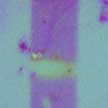Showing Spotlights 641 - 648 of 2786 in category All (newest first):
 Graphene bioelectronics has become a ground-breaking field that offers exciting opportunities for developing new kinds of sensors capable of establishing outstanding interfaces with soft tissue. Graphene-based transistors, as well as electrode arrays, have emerged as a special group of biosensors with their own peculiarities, advantages and drawbacks. A new review present sa comprehensive overview of the use of graphene for bioelectronics applications; specifically the focus is on interfacing graphene-based devices with electrogenic cells, such as cardiac and neuronal cells.
Graphene bioelectronics has become a ground-breaking field that offers exciting opportunities for developing new kinds of sensors capable of establishing outstanding interfaces with soft tissue. Graphene-based transistors, as well as electrode arrays, have emerged as a special group of biosensors with their own peculiarities, advantages and drawbacks. A new review present sa comprehensive overview of the use of graphene for bioelectronics applications; specifically the focus is on interfacing graphene-based devices with electrogenic cells, such as cardiac and neuronal cells.
Sep 3rd, 2018
 Nanotechnology researchers now have developed a natural and non-damaging hair surface engineering technique for making hair coloring formulations that do not use any chemical reactions but instead relies only on physical forces acting at a very close range. The same surface engineering approach is applicable to textile microfiber modifications because natural textiles like like wool, silk, cellulose, but also biomimetic synthetic textiles, have similar chemical composition.
Nanotechnology researchers now have developed a natural and non-damaging hair surface engineering technique for making hair coloring formulations that do not use any chemical reactions but instead relies only on physical forces acting at a very close range. The same surface engineering approach is applicable to textile microfiber modifications because natural textiles like like wool, silk, cellulose, but also biomimetic synthetic textiles, have similar chemical composition.
Aug 30th, 2018
 Achieving high-quality crystalline TiO2 films at room-temperature remains one of today's most important technical challenges toward low-cost optoelectronic devices including photovoltaic cells and photocatalytic device architectures. A research team has now demonstrated a simple method for triggering the crystallization of a TiO2 sol-gel precursor at low-energies. With this technique, it is now possible to achieve 90% crystallinity without metallic dopants, at room temperature and in ambient air, using low-power laser-induced photoactivation of an amorphous TiO2 nanoparticle film.
Achieving high-quality crystalline TiO2 films at room-temperature remains one of today's most important technical challenges toward low-cost optoelectronic devices including photovoltaic cells and photocatalytic device architectures. A research team has now demonstrated a simple method for triggering the crystallization of a TiO2 sol-gel precursor at low-energies. With this technique, it is now possible to achieve 90% crystallinity without metallic dopants, at room temperature and in ambient air, using low-power laser-induced photoactivation of an amorphous TiO2 nanoparticle film.
Aug 23rd, 2018
 By employing 3D scaffolds with both aligned nanofibers and aligned interconnected macrochannels, researchers have taken a nanotechnology-based tissue engineering approach to accelerate the regeneration and repair of damaged tissues at the wound site by directing cells and tissues to grow towards the target site. Their hope is that this leads to the development of affordable and functional biodegradable wound dressings for accelerated healing of chronic skin wounds by promoting regeneration of local tissues.
By employing 3D scaffolds with both aligned nanofibers and aligned interconnected macrochannels, researchers have taken a nanotechnology-based tissue engineering approach to accelerate the regeneration and repair of damaged tissues at the wound site by directing cells and tissues to grow towards the target site. Their hope is that this leads to the development of affordable and functional biodegradable wound dressings for accelerated healing of chronic skin wounds by promoting regeneration of local tissues.
Aug 16th, 2018
 Researchers have developed an all-optical lithographic technique called 'optothermoplasmonic nanolithography' (OTNL) to achieve high-throughput, versatile, and maskless patterning of different atomic layers. Taking graphene and molybdenum disulfide monolayers as examples, the team shows that both thermal oxidation and sublimation in the light-directed temperature field can lead to direct etching of the atomic layers. They further demonstrates programmable patterning of 2D materials into complex and large-scale nanostructures by steering the laser beam.
Researchers have developed an all-optical lithographic technique called 'optothermoplasmonic nanolithography' (OTNL) to achieve high-throughput, versatile, and maskless patterning of different atomic layers. Taking graphene and molybdenum disulfide monolayers as examples, the team shows that both thermal oxidation and sublimation in the light-directed temperature field can lead to direct etching of the atomic layers. They further demonstrates programmable patterning of 2D materials into complex and large-scale nanostructures by steering the laser beam.
Aug 14th, 2018
 Though nanotechnology is portrayed as a fairly recent human invention, nature is actually full of nanoscopic architectures. They underpin the essential functions of a variety of life forms, from bacteria to berries, wasps to whales. In fact, tactful use of the principles of nanoscience can be traced to natural structures that are over 500m-years-old. Below are just five sources of inspiration that scientists could use to create the next generation of human technology.
Though nanotechnology is portrayed as a fairly recent human invention, nature is actually full of nanoscopic architectures. They underpin the essential functions of a variety of life forms, from bacteria to berries, wasps to whales. In fact, tactful use of the principles of nanoscience can be traced to natural structures that are over 500m-years-old. Below are just five sources of inspiration that scientists could use to create the next generation of human technology.
Aug 13th, 2018
 By combining advanced high-precision electron microscopy and computational methods, researchers have shed new light on the role of strain in nanoparticle catalysis. Catalytic metal nanoparticles supported on oxide substrates are used on a large scale in technological applications such as production of chemicals, abatement of air pollution and sustainable energy systems. The overall performance and durability of these systems is influenced by a range of factors, and every improvement could result in noticeable environmental and economic benefits.
By combining advanced high-precision electron microscopy and computational methods, researchers have shed new light on the role of strain in nanoparticle catalysis. Catalytic metal nanoparticles supported on oxide substrates are used on a large scale in technological applications such as production of chemicals, abatement of air pollution and sustainable energy systems. The overall performance and durability of these systems is influenced by a range of factors, and every improvement could result in noticeable environmental and economic benefits.
Jul 31st, 2018
 Traditional CMOS technology cannot be directly merged with graphene applications. Photo- and electron-based lithographies, which are the main processess in today's semiconductor industry, requires use of polymers and harsh liquids that can drastically alter the initial properties of graphene. Thus graphene requires the development of novel processing technologies.
A international team of researchers now has developed a method for direct, on-the-fly reconstruction of graphene properties.
Traditional CMOS technology cannot be directly merged with graphene applications. Photo- and electron-based lithographies, which are the main processess in today's semiconductor industry, requires use of polymers and harsh liquids that can drastically alter the initial properties of graphene. Thus graphene requires the development of novel processing technologies.
A international team of researchers now has developed a method for direct, on-the-fly reconstruction of graphene properties.
Jul 30th, 2018
 Graphene bioelectronics has become a ground-breaking field that offers exciting opportunities for developing new kinds of sensors capable of establishing outstanding interfaces with soft tissue. Graphene-based transistors, as well as electrode arrays, have emerged as a special group of biosensors with their own peculiarities, advantages and drawbacks. A new review present sa comprehensive overview of the use of graphene for bioelectronics applications; specifically the focus is on interfacing graphene-based devices with electrogenic cells, such as cardiac and neuronal cells.
Graphene bioelectronics has become a ground-breaking field that offers exciting opportunities for developing new kinds of sensors capable of establishing outstanding interfaces with soft tissue. Graphene-based transistors, as well as electrode arrays, have emerged as a special group of biosensors with their own peculiarities, advantages and drawbacks. A new review present sa comprehensive overview of the use of graphene for bioelectronics applications; specifically the focus is on interfacing graphene-based devices with electrogenic cells, such as cardiac and neuronal cells.
 Subscribe to our Nanotechnology Spotlight feed
Subscribe to our Nanotechnology Spotlight feed





